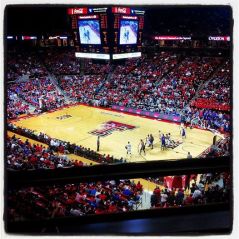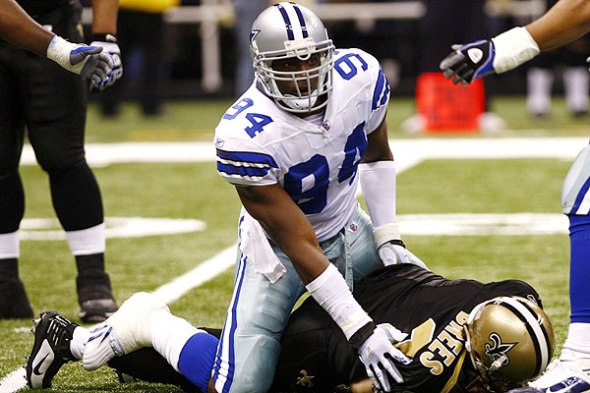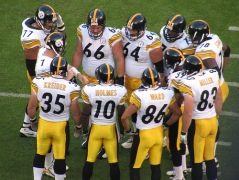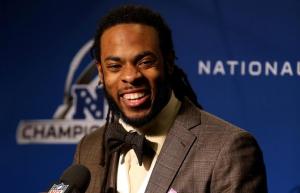

ESPN’s two-hour 30 for 30 special, “Requiem for the Big East”, chronicled the dramatic rise — and equally captivating collapse — of college basketball’s premier league, the Big East Conference.
In short, the money being earned by the conference’s bigwigs, such as Georgetown and Syracuse, combined with the influence of college football’s independent Eastern powers and the birth of the Bowl Championship Series to create a cluster of diverse and unequal interests.
It was destined to fall.
And may I add my own brush to this canvas? College basketball as a whole rose with the Big East, and collapsed with her as well. The shoe money seeped into the youth game, creating a world governed by Nike and Adidas and not by high schools or smart AAU coaches. The outside interests really did the sport in.
Let’s take an in-depth look at what really went wrong with the college game.
PART ONE: THE FOOTBALL PROBLEM/SOLUTION/PROBLEM
For the first 12 seasons of its existence, the Big East Conference was basketball-centric, surrounded with like-minded schools of varying levels of success. From powers such as Georgetown, Syracuse, St. John’s and Villanova to minnows like Seton Hall and Boston College, the conference was basketball heaven for those in the Northeast. The league was aided in its success by the birth and growth of ESPN and the convenience of being in proximity to the nation’s media powers, such as New York City, Boston, Philadelphia and Washington, D.C.
The money earned by the Big East was unfathomable, and the fame of its players and coaches was beyond comparison. It was the East’s answer to the mighty SEC, which put its football icons on a regional pedestal and carved them into Southern superstars. It helped rein in elite Atlantic Coast talent which usually would’ve retreated to the ACC or the SEC, and created a reputation for its characters and high quality of play.
When Dave Gavitt, the Big East’s leader and advocate, left for the Boston Celtics in 1990, the league took on a corporate atmosphere as greed began to creep into its corners. College football, the increasingly relevant superpower of state-university athletics, began to knock on the Big East’s door — very loudly. At the time, the league was a collection of a handful of state schools and the elite Catholic institutions which couldn’t afford nor find a care to field a team on the gridiron. That didn’t phase the Big East: In came the University of Miami in 1991, its abysmal (and recently reborn) basketball program gathering up dust in a hoops haven.
But that didn’t matter anymore. Football was calling the shots.
This was the birth of conference realignment as we know it.
In 1995, West Virginia and Rutgers moved the rest of their athletic department inside the Big East universe, having played football in the league since 1991. Virginia Tech followed suit in 2000, also an original football school within the conference. (Temple only played football in the Big East from 1991 to 2005.) Pittsburgh, Syracuse, Connecticut, and Boston College always had football, but moved their teams in with the other five additions in ’91.
Once these schools — with varying levels of basketball ambition — made their way into the Big East, the size and management of the conference’s hoops affiliations proved difficult, which became the league’s main conflict of interest for the next 17 seasons.
One thing proved true: that storied tournament in New York City, held in Madison Square Garden, was game for each of those teams — from mighty Georgetown to lowly Virginia Tech and middling Providence. It became nearly untenable.
Meanwhile, ESPN began to pay more attention to the surging interest in college football, being beamed across America in growing amounts. The two sports have always seen themselves as central to their university’s identity, but usually one truly prevails. As financial issues began to creep up in college athletics — who really pays for the golf or women’s water polo teams, Hoss? — it became clear that college football was the real golden egg that everyone should begin to chase.
With these conclusions reached, college football became front and center for ESPN and the rest of the media. Schools where basketball could enjoy marginal attention and success — read Alabama, or Florida, or Ohio State, or Oregon — began to be swallowed up by the 24/7 football news machine. Recruiting websites popped up, regulating talent in both football in basketball via a “star system”. Spring football became as routine as Midnight Madness once was, and the storylines behind those events became goldmines for information to starving football fans.
Meanwhile, the Big East still produced elite talent, thanks to the security that network TV contracts gave to the league. Teams were still winning tournaments and making major ripples in the world of college hoops. But the thing was: it was losing its luster.
PART TWO: THE SNEAKER PROBLEM
“It’s gotta be the shoes.”
Surely, it is.
College basketball and college football are married to one another, and neither is really hunky-dory about it.
To be brutally honest, Under Armour — which made its money off form-fitting football apparel, made famous by catchy advertising — is not a good basketball brand. None of its clients (including noted basketball power, Maryland) are dedicated to winning basketball games, nor are they particularly powerful and competitive programs (that includes you, Texas Tech).
The association of football and basketball apparel has also killed college basketball. Case in point? Under Armour thinks it’s a basketball shoe brand. It is not, and it never will be.
In the 21st century, established basketball-friendly companies such as Nike, Adidas, and Reebok have made inroads into the influential world of travel basketball — which, like it or not, has been making decisions for young 18-year-old recruits since shoes were cool.
The rise of college football took away much-needed resources, interest, and sound insight from college basketball, whose equally enormous ego has forced the non-Duke, non-Kentucky, non-UNC, and non-Kansas schools to go on the defensive when another one of their top-ranked in-state recruits tells them they’re too much of a “football school” and sign with one of those four aforementioned programs.
This isn’t a knock on college football. But it’s zapped the interest out of hoops, playing a major role. Tying non-basketball companies such as Under Armour to a sport which is foreign to them is a guaranteed recruiting killer. Look at Maryland: once a competitive program protected from the UA bubble by the influential Gary Williams, it has not succeeded anywhere on the recruiting trail in the UA/Mark Turgeon era. They also are teetering on the brink of irrelevance, being sashayed into the Big Ten Conference this fall for the sole purpose of looking good in football season.
In short, the fact that basketball and football teams have to share athletic apparel companies can hurt — and it’s basketball that’s getting the hurtin’. But such is normal in the high-stakes, football-first world of college sports. It’s where the MONEY is.
PART THREE: THE NBA DRAFT PROBLEM
Once upon a time, parents tell us, college basketball was exciting.
The personalities jumped out of the TV screen. The gyms were packed. The talent was boiling over like a teapot.
Nowadays, outside of the traditional bigwig basketball schools — namely Duke, North Carolina, Kentucky, Kansas, and Arizona — nobody gives a damn anymore.
Why?
Let’s walk back to 1995, when Kevin Garnett – basketball’s foremost power forward, all respects to Tim Duncan – decided to make the leap (it was a LEAP!, they wrote) from high school straight into the National Basketball Association. Garnett was picked up by the Minnesota Timberwolves and proceeded to craft a Hall of Fame career with two different franchises, winning an NBA title in 2008 with the Celtics.
Garnett’s trailblazing move created a market for high school talent, mainly unmotivated by rah-rah college guys running up in their houses at midnight and asking them weird questions about life, to follow his lead and go forth into professional basketball. Kobe Bryant, one of the game’s great guards and a surefire Hall of Famer, took the jump in ’96 and became a Los Angeles Lakers legend.
LeBron James did the same thing in 2003, when he became the third high-school player of the era to make a major impact in the NBA. So far, he has quite possibly racked up the most accolades of the bunch, while crafting a legacy as both a champion and a villain to millions of Americans. Two years later, the NBA outlawed the charade, relegating those players to the collegiate ranks for a season prior to their NBA debuts.
This was the death knell for a seemingly reborn version of college hoops.
Why?
- College basketball already had one-and-dones. Carmelo Anthony, Gerald Wallace, and Gilbert Arenas had, in recent seasons, made the single-season leap to the NBA in the high school era. All three were, and are, All-Stars and became the faces of basketball franchises. College hoops saw this happen occasionally, but the 2005 ruling opened up Pandora’s box for a universe where any college player could jump to the big leagues at 19 years old.
- It created the possibility of superteams. Kentucky under John Calipari, the Godfather of the one-and-done rule and its unabashed advocate, has become the face of modern college basketball. His effective system has sent dozens of top-10 draft talent off to the NBA, hoarding much of college basketball’s best recruits for his personal crafting. Other schools were left punchless, including Duke — whos’s changed to keep up — and Kansas.
- If you weren’t a “basketball school” beforehand, good luck trying. Despite Texas’ success with Kevin Durant (losing to USC in the 2007 Round of 32), USC’s brief talent boom with Nick Young and O.J. Mayo, and Kansas State’s one-year experiment with Michael Beasley, most elite recruits were going to gravitate to the One-Year NBA Farm Teams evolving out in Kansas and Kentucky, two of the college game’s most gratuitous beneficiaries of the rule. Other teams in contention, outside of powers such as Syracuse or UNC or Duke (or even Ohio State or Michigan State or Michigan), were left with rejection letters — being told they were a “football school” and not worthy of their time. The Canadian basketball boom also led to a ticket race, with most to all of the young men coming from North of the Border making a one-year pit stop (Andrew Wiggins).
- One-and-dones killed the nation’s interest in college hoops. Period. To learn that Texas got this top-three recruit, and then to learn that he’s just here until he’s guaranteed a top-10 spot in the draft by his soon-to-be-agent, kills a school’s interest in basketball. This is possibly the second-biggest reason why college basketball has been rendered irrelevant: not only has football’s offseason (pro and collegiate) become a media circus worthy of ESPN’s time, college hoops has become diluted with faceless, nameless, careless stars, ready to cruise their way through a half a semester of campus life before bolting to the NBA. Meanwhile, not only is college football better (and more colorful – thanks Oregon!), it retains all of its stars and creates more – partially because of our national over-analysis of the gridiron game, but also because the NFL won’t let those guys jump until their third season of college is finished.
Adam Silver, the newly crowned commissioner of the NBA, has realized this massive gulf between the NBA and the college game – NBA fans are bored with the college game (as are most Americans), and college fans hate the NBA (as do many Americans) – doesn’t help the NBA or the college game.
Basketball at its grassroots is at a crisis, fueled by greed birthed in the Big East. That’s why there was a 16-team tournament in the league’s decadent days; purely unskilled teams such as South Florida and Rutgers were sharing the court with basketball powers such as Connecticut and Syracuse.
No one is watching as the tree is falling in the backyard. They’re just bickering over which side of the fence the tree is going to fall.
College basketball is falling, and fast. Let’s hope there can be a person who can solve the bickering.
For the love of the sport of basketball.
For the relevance of the pro and college game amidst a sea of Adam Schefter and Nick Saban.
For the Duke fan, for the Syracuse fan, and for the memory of the Big East Conference: a requiem for the game of basketball itself.
Philip Arabome is a sophomore journalism major. He is the Sports Director at KTXT-FM in Lubbock and the host of the Walk-Off, a sports-related show which airs Tuesdays at 5pm CST. Follow him on Twitter: @PhillyBeach93











